君子不器 依仁游艺
——忆饶宗颐先生
文王岳川 WANG Yuechuan
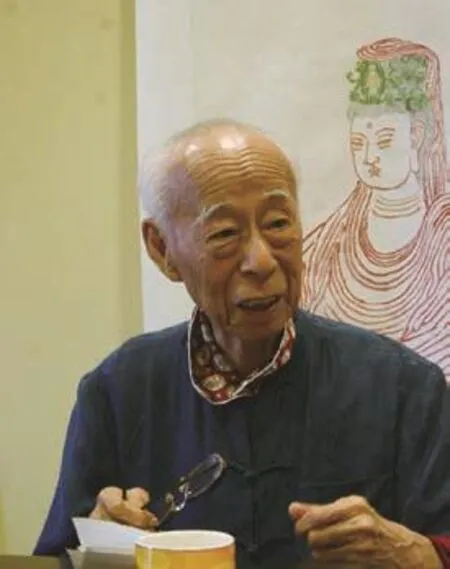
被称之为“南饶北季”的饶宗颐先生于2月6日去世,无疑是中国文化界的一大损失。
饶宗颐学术艺术道路非常广阔,可谓达到了孔子所说的“君子不器”的理想高度。季羡林说“心目中的大师就是饶宗颐”,钱钟书说他是“旷世奇才”,金庸说“有了饶宗颐,香港就不是文化沙漠”。饶先生学贯中西,获誉多多:曾获多项奖誉、荣誉博士及名誉教授衔,包括法兰西学院“儒莲奖”、法兰西学院外籍院士、巴黎亚洲学会荣誉会员、法国高等研究实践学院首位华人荣誉人文科学博士、香港政府大紫荆勋章、香港艺术发展局终身成就奖等,足见学界评价之高!
饶先生的学术艺术境界高迈出尘——出经入史、博大精深、诗文书画、著作等身。一个学者在101年的寿命中能写出60多部著作、 500多篇论文,还精通六七门外语,再加上书法、绘画,令人匪夷所思。我认为饶先生的成就可以概括十个方面:敦煌学、甲骨学、词学、史学、目录学、楚辞学、考古学、金石学、书法绘画和诗学美学。这十个方面,饶先生以一人之力,做出了可贵的贡献。
国学精神 天人互益
学术界有一个基本共识:“南饶北季” ,即南方有香港的饶宗颐先生,北方有季羡林先生。这两位学术大师都精通数门外语,著作等身,学术上达到相当高的境界。但他们没有关门做学问,而是心系天下——关注全球化中的中国文化命运!饶先生治学的方法论,对我们做学问,包括做书法学、美术学研究的都很有启发:
其一,勇于推陈出新。推陈出新强调方法新、观点新、材料新。我注意到王国维先生的“二重证据法”:出土文物加上纸上的文献。文献是文字的,出土文物是实物的,二者可以佐证史实的真实性。饶先生又加了一个新东西——甲骨文。甲骨文既是地下出土的,但是它的价值不是看甲骨,而是甲骨上的文字,所以它又是文献。我认为这是继王国维之后的一大学术推进。
其二,饶先生非常看重国学与中国传统的意义,在方法论上注重“中西佐证”。有些学者仅仅是拿中去比西,或拿西去比中,这都有很大的问题。饶宗颐先生认为,中国文化的主体是经学,国学就是本国的文化,每个国家都有本国的文化,把中华文化称为国学,放到世界上就不通了,因此他主张更准确应该称为“汉学”或“华学”。就此而言,他对古经史深怀难以表达的敬意,强调研究国学不能亵渎“国本”,要爱惜敬重“古义”,顺着中国文化的经络本义阐发经史,并用“大文化”的眼光看中国的材料并佐以西学脉络,从这一点来讲,在学问上是深情冷眼地“中西汇通”。
其三,学术理性的怀疑和创新精神。这是作为一个学者最重要的品格。他对疑古派过分地怀疑中国历史提出批评,包括对疑古派学者把中原地盘越说越小提出不同意见。他的研究应该是对中国文化深层结构和远古精神的揭示。对世纪学术各家各派,皆是取长补短,独出机杼。饶宗颐说:“正如鲁迅先生所讲,近代学者往往受哪个国家、哪个学派影响,我则尽量多些接触各国、各学派的学者,包括在美国1年,日本4年,新加坡5年,英、法、西班牙、印度等地几个月。到那里潜下心来研究当地的课题,决不一知半解就以为窥见全豹,自鸣得意。”
其四,文学研究上大胆运用比较文学方法。季羡林认为:饶宗颐教授运用比较文学的方法,探讨中国古代文学的源流,对于我们研究中国古代文学史也有很多启发。饶先生在《汉字与诗学》一文中认为关键就是汉字——中国汉文诗的特点与汉字有紧密的联系。饶先生在他的文章中探讨了一些与诗的形式有关的问题,韵律也在探讨之列。所有这一切都是从汉字这个特点出发的。

皋兰山写生(中国画)饶宗颐Sketching of Gaolan Mountain, (Chinese Painting) Jao Tsung-i
书法超迈 独出机杼
饶宗颐幼年从唐颜真卿入手,临写《颜勤礼碑》《颜氏家庙碑》《麻姑仙坛记》;然后,为强健腕力转而写《张猛龙碑》《爨宝子碑》;后为求结构森严精准,对唐欧阳询《化度寺碑》下过苦功;为求书法意趣之美,转而对宋苏、黄、米三家行书刻意临写,领略其中意趣。中年以后,因为学术研究所及敦煌学和甲骨学,著有《战国楚简笺证》《编钟铭释》《居延零简》《日本所见甲骨录》《巴黎所见甲骨录》《长沙出土战国缯书新释》《海外甲骨录选》《殷代贞卜人物通考》,这无疑影响到他的书法趣味和风格,故而形成中年变法,对甲金、简帛及汉隶情有独钟,朝夕临习不辍。饶宗颐在《论书十要》中说:“新出土秦汉简帛诸书奇古悉如锥书,且皆是笔墨原状,无碑刻臃肿、断烂之失,最堪师法。触类旁通,无数新蹊径,正待吾人之开拓也。”
医学教育作为卫生健康事业的重要基础,是高等教育的重要组成部分,也是教育强国建设和健康中国建设的重要内容。将继续积累和总结教学经验,在实践中不断改进完善教学改革内容,为我校培养更多具有“仁心妙术”的高素质医学人才。
进入晚年,他对敦煌书法长期专攻,选取巴黎所藏敦煌经卷精萃编为《敦煌书法丛刊》29册,化所有学术和书法养料而成就自我书法风格,终于形成不同于各家各派的古文字书法风格。他既不走民间书法的道路,也不走西方抽象画书法道路,而是坚定地走熔铸传统、汇通碑帖的大美之路,广泛涉猎帖学、简牍、甲骨、魏碑等,融会贯通而自成面目。
饶先生的书论思想有自己的美学原则。他在《论书十要》里主张书体要“重”“拙”“大”而拒绝“轻佻、妩媚、纤巧”,行笔避免熟滑、甜俗而要厚重耐看,临帖习碑要手摹心迫,细读深思,不可只求形似;书道讲求“墨色酣畅,线条淋漓,人天凑泊”等。在我看来,中国的书家不少,学者很多,但是书法能写到饶先生这样精到、自成面目、学古不泥古的,实不多见。这与饶宗颐先生的书法态度很有关系——不屑于书法山头主义、流派主义,他日课临帖与常常独处,甚少出门,几乎不应酬。重视精神的独处和生命的修炼,才能有书法的无言大美。
文人绘画 沉劲老辣
饶宗颐先生在中国文人画创作上倾注了巨大的精力并获得公认的艺术高度。他在文人画创作上新法迭出,行内外人士公认,其成就绝不在学术之下。
文人画到了饶宗颐先生这里,有了新的变化。他不再热衷于对摹原作的形似,而在自己的山水画写景或造景山水中浸透着对古人精品的深刻洞悉,以他郁勃的学术之气和生命感悟在笔墨情趣中散发出山川之魂。画家黄苗子认为,饶宗颐绘画之所以“落笔便高”,是和他广博的学问分不开的。美术史家万青力认为,饶宗颐绘画已超越传统“文人画”,是中国绘画史上极其罕有的“学者画”。
到了晚年,饶宗颐形式的创作力勃然迸发,尤其在他热爱的敦煌题材的绘画上,以一种天老地荒、沉劲老辣的笔势,一大块的涨墨和枯润相间的大写意笔法描绘敦煌壁画的画意,透过形似而达到神似,进而直追北魏、隋唐,为敦煌绘画开了新的文人画的美学路径。21世纪初,饶宗颐不满足中国绘画史论中的“南宗”“北宗”之争,独辟蹊径地提出中国山水画“西北宗”之说,并特立独行用自我独创的笔法墨法和天风浩荡的结构气象,为西北雄奇山水写神,实践着山水画“西北宗”的美学原则。
历史会铭记饶宗颐这位君子不器、依仁游艺的大学者!

①铸古今异字(书法)饶宗颐Unique characters of ancient and modern China (calligraphy) Jao Tsung-i
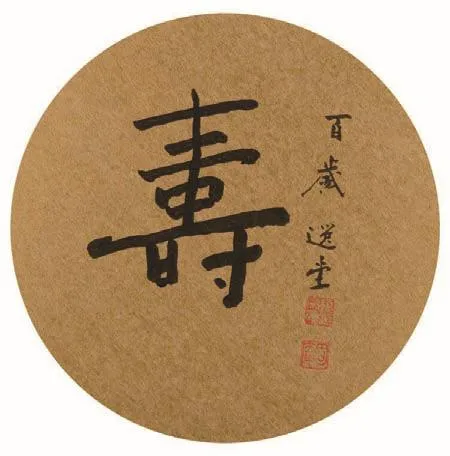
②寿(书法)饶宗颐Longevity (calligraphy)Jao Tsung-i
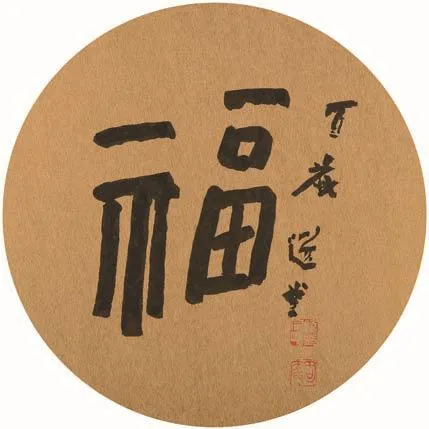
③福(书法)饶宗颐Blessing (calligraphy) Jao Tsung-i
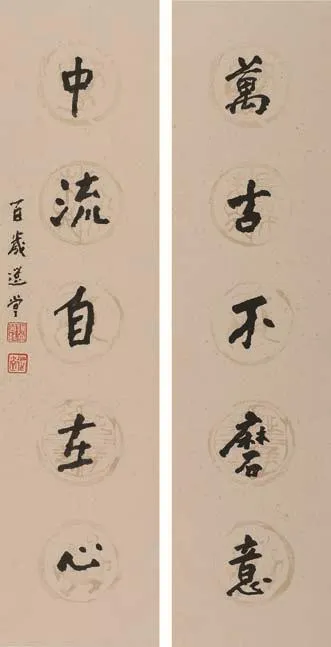
④万古不磨意 中流自在心(书法)饶宗颐Unchangeable Willingness, Durable Faith (calligraphy) Jao Tsung-i
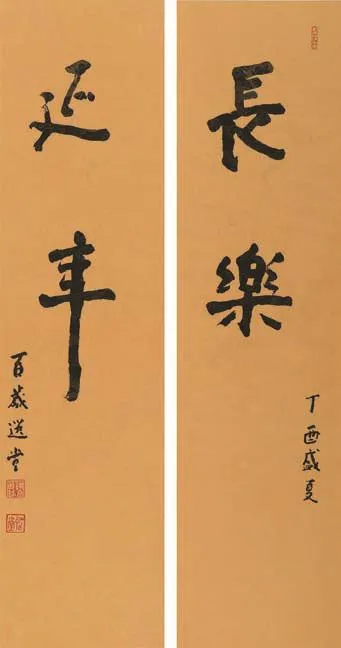
⑤长乐延年(书法)饶宗颐Longevity with joy (calligraphy) Jao Tsung-i
With a most broad path in both academy and art, Mr. Jao is considered to have reach the ideal height of what the Confucius called the “exemplary persons are not mere vessels”.Mr. JIXianlin said that “the great master in his mind is Mr. Jaotsung-i”, Mr. QIAN Zhongshu called him a “matchless genius” and Mr. Louis Cha said that “Hong Kong is not a cultural desert with the presence ofMr.Jao Tsung-i”. Having learned from both the Chinese and Western cultures, he has won many reputation: receiving a number of awards, honorary doctorates and honorary professorships,including “Julien Award” of Institution of France, Foreign Academician of Institution of France, Honorary Member of the Asian Society of Paris, First Chinese Doctor of Humanities and Humanities of France Higher Institute of Research and Practice,Grand Bauhinia Medal from Hong Kong Government, Lifetime Achievement Award of Hong Kong Arts Development Council, etc.,reflecting the high commendation from the academic community.With unprecedented and in-depth academic and artistic realm,Mr. Jao had profound knowledge in history, poetry, calligraphy,works and others. It was truly incredible that a scholar could write more than 60 books and over 500 dissertations in his life span of 101 years. He was also proficient in six or seven foreign languages, together with achievement in calligraphy and painting.Mr. Jao’s accomplishments, in my opinion, can be summed up in 10 aspects: Dunhuang studies, oracle bone studies, studies of words,historiography, bibliography, Chuci studies, archeology, philology,calligraphy, painting and poetry aesthetics. In these ten aspects,with the strength of an individual, Mr.Jao has made a valuable contribution.
Mutual Benef i t of Sinology Spirit
There is a basic consensus in the academic community: “Jao of South and JI of North”, indicating Mr.Jao Tsung-i from Hong Kong to the south and Mr. JI Xianlin to the north. The two academic masters are proficient in several foreign languages and literature works etc., reaching a very high academic level. However, they didn’t only cast attention to learning, but showing their concerns to the whole world---paying attention to the Chinese cultural destiny in globalization! The methodology for scholarship of Mr.Jao inspires for us to learn, including the study of calligraphy and fine arts:
Firstly. Courage for innovation. It highlights the new methods,ideas and materials. I have noticed Mr. WANG Guowei’s Double Evidence Method: unearthed cultural relics and paper documents.Literature is literal, and unearthed cultural relics are physical objects that can support the authenticity of historical facts. Mr.Jao has added another new perspective–oracle bone inscription,which were unearthed underground. However, its value is not to research the oracle bones, but the text on it, which is also a document accordingly. I think this is a major academic advancement after the achievement of Mr. WANG Guowei.
Secondly. Mr. Jao highly valued the significance of sinology and Chinese traditions, casing attention to the Evidence of both Chinese and Western in methodology. Some scholars simply compared the Chinese connotation to Western connotation or reverse, which is of large problem. According to Jao Tsung-i, the main body of Chinese culture is Confucian studies. The sinology is the culture of China. Each country has its own culture. And it is unreasonable on a global scale when calling the Chinese culture the sinology. Therefore, he advocated more accurately that it should be called “Han School of Classical Philology” or “Chinese learning". In this regard, he expressed his deepest esteem for the Confucian classics and history, stressing that the study of sinology should not desecrate the Fundamental Principles of Country,but to cherish the respect of "ancient meaning", interpret the Confucian classics and history along the origins of the Chinese culture, preserve all the materials concerning China with view of Big Culture partially supported by the context of Western culture.From this point of perspective, he was a man Understanding All Issues from East and West with a cold eye.
Thirdly. Academic rationality and innovation. This is the most important character of a scholar. He criticized the suspiciousancient-school for excessively suspicion of Chinese history,including disagreement with scholars of such school to make the area of China’s central plains smaller and smaller. His research should reveal the deep structure and ancient spirit of Chinese culture, learning from every academic faction of the century academics. Mr. Jao said: "As Mr. LU Xun spoke, modern scholars are often influenced by countries and schools. I try to make more contacts with scholars from various countries and schools of thought, including 1 year in the United States, 4 years in Japan, and 5 years in Singapore and months in France, Spain, India, and other places, thoroughly committing myself to research of local topics".Fourthly. The bold use of comparative literature in literary studies.According to Mr. JI Xianlin: Professor Jao uses the methods of comparative literature to explore the origins of ancient Chinese literature, inspiring us to study the history of ancient Chinese literature. Mr. Jao believes that the Chinese characters play the key role in the article of "Chinese Character and Poetics" - the characteristics of Chinese poetry are closely related to Chinese characters.In his article, Mr. Jao discussed some issues related to the form of poetry, and rhythm as well,all of which is based on the characteristics of Chinese characters.
Supreme Attainments in Calligraphy
Starting learning from YAN Zhenqing of Tang Dynasty in his childhood, Mr. Jao copied theYAN Qinli Inscription, YAN Shi Jiamiao InscriptionandMaguXiantanji, followed byZhangmenglong InscriptionandCuanbaozi Inscriptionin order to strengthen his wrist force, studyof Huadu Temple Inscriptionof OUYANG Xun of Tang Dynasty for precise and accurate structure,copy of running script of SU Shi, HUANG Tingjian and MI Fu of Song Dynasty for the beauty of calligraphy in order to understand the inner charm. Into his middle age, due to the academic research institute, studies of Dunhuang and oracle bone, Mr. Jao has composed the WarringStates Chujianzheng, Bianzhong Mingshi,Ju Yan Ling Jian, Oracle Archives Seen in Japan, Oracle Archives Seen in Paris, New Interpretation of Warring States Period Books Unearthed in Changsha, Selection of Overseas Oracle Records, andRecords of Divination Figures of Yin Dynasty,which undoubtedly affected his calligraphy interest and style, resulting in the law changes at his middle age. He was keen on characters of Jin dynasty on oracles, bamboo slip and silk, and official script of Han dynasty with much endeavor. Mr. Jao Tsung-i noted in the Ten Musts of Books: newly-unearthed books of bamboo slips and silks of Qin Dynasty are of intact conditions, showing slim structures and unprecedented skills. The new methods embedded are waited to be explored.
In his later years, he had a long-term commitment in Dunhuang calligraphy. He chose the essence collection of Dunhuang scriptures in Paris and composed the “Dunhuang Calligraphy Series”, a 29-volume edition, transforming the entire academic and calligraphy nourishments into his own calligraphy style and finally forming a different style from the various factions, an ancient calligraphy style. He did not take the road of folk calligraphy,nor the road of Western abstract calligraphy. Instead, he firmly adhered to the road of great beauty that melts the tradition and inscriptions, extensively involving in the study of calligraphy copybook, bamboo slips, oracle bones, and Wei Inscription,forming his exclusive style.
Mr. Jao had his own aesthetic principles concerning the book theory. In hisTen Musts of Books,he advocated that the body of the calligraphy should be "Heavy" "Dull" and "Large", but not"Light, Enchanting, Thin", avoiding being slippery and vulgar in writing while focusing on thick and durable, following hands and hearts in copying inscriptions with deep thought and adhering to Bright Ink, Smooth Lines and Natural Combination etc. In my opinion, there are many calligraphers and scholars in China,however, it is truly rare to find someone whose calligraphy capacity is as much as that of Mr. Jao in mastery, unique style and free acknowledgement of ancient tradition. This has a lot to do with his calligraphic attitude — disdain to mountain-stronghold mentality in calligraphy and genreism. He was devoted to daily writing with his own shadow and few social activities. Only through focusing on spiritual solitude and cultivation of life can it lead to the beauty of calligraphy beyond words.
Sophisticated Style in Literati Painting
Mr. Jao Tsung-i has devoted great energy to the creation of Chinese literati painting and attained the art height acknowledged by the public. He has made much new practice in the creation of literati painting, and the pertinent achievements were by no means lower than that of his academic gains, which were recognized by people of all fields.The literati painting generated new changes due to Mr. Jao,who was no longer passionate about the shape of the original manuscript, but holding profound insight of great artworks of ancient times deeply immersed in his landscape paintings or painting of artificial landscapes. According to painter HUANG Miaozi, the reason why Jao Tsung-i's paintings had “great acknowledgement” was inseparable from his extensive knowledge. WAN Qingli, an art historian believed that the painting of Mr. Jao has surpassed the traditional Literati Painting, and was an extremely rare "painting of scholars" in the history of Chinese painting.
In his later years, the creative power of Mr. Jao tsung-i burst out,especially on the paintings of Dunhuang that he loved. With an ever-lasting and sophisticated gesture while using the freehand brushwork with integration of large area of ink together with substantial dryness to depict the artistic conception of Dunhuang murals, he has opened a new aesthetic path of literati paining for the Dunhuang murals via the form of a similarity to realize the genuine likeness so as to pursue the Northern Wei Dynasty and the Sui and Tang Dynasties. At the beginning of the 21st century,due to his discontent over the disputes between the “Southern Bound” and “Northern Bound” in the history of Chinese painting, he proposed a unique way to put forward the theory of“Northwestern Bound” in the field of Chinese landscape painting,and used his unique brushstroke method and magnificent voluminous structural phenomena to paint the majestic landscape of the northwestern part of China, while practicing the aesthetic principles of the Northwestern Bound in the field of landscape painting.
A great scholar of “Exemplary Persons are Not Mere Vessels,Practice by Virtue and Skills”, Mr. Jao Tsung-i will be remembered by the history.
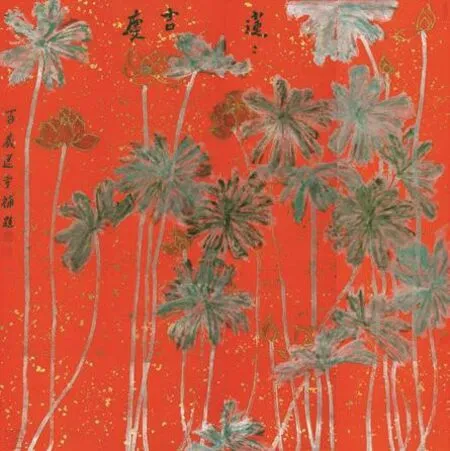
莲莲吉庆(中国画) 饶宗颐Glamour of the lotus (Chinese Painting) Jao Tsung-i

